A glossary of terms, commonly used in discussing pinball machines.

Medieval Madness is a Williams pinball machine released in June 1997. Designed by Brian Eddy and programmed by Lyman Sheats, it had a production run of 4,016 units. As of April 3, 2022, the Pinside pinball community lists it as the #2 highest-ranked pinball machine ; many adherents consider it the greatest of all time.
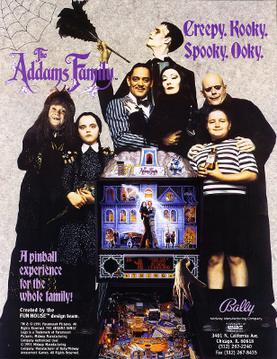
The Addams Family is a pinball machine released in March 1992. It was designed by Pat Lawlor and Larry DeMar and released by Midway. It was based on the 1991 film of the same name, and features custom speech by the stars of the film, Anjelica Huston and Raul Julia. It is the best-selling solid state pinball machine of all time with 20,270 units sold.

Star Trek: The Next Generation is a widebody pinball game, designed by Steve Ritchie and released in November 1993 by Williams Electronics. It was part of WMS' SuperPin series, and was based on the TV series. It is the only pinball machine that features three separate highscore-lists. Apart from the regular highscore-list and the buy-in-list, it also features a reminiscence to The Machine: Bride of Pin*Bot billionaires club. It is also the third pinball game overall based on the Star Trek franchise, following the 1979 pinball game by Bally, and the 1991 game by Data East, and preceding the 2013 pinball game by Stern.
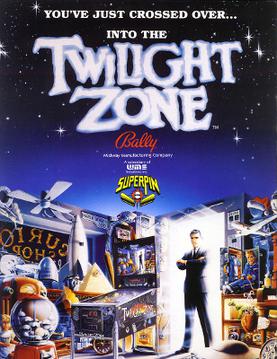
Twilight Zone is a widebody pinball machine, designed by Pat Lawlor and based on the TV series of the same name. It was first released in 1993 by Midway. This game is part of WMS' SuperPin line of widebody games alongside Star Trek: The Next Generation and Indiana Jones: The Pinball Adventure.

Attack from Mars is a 1995 pinball game designed by Brian Eddy, and released by Midway.

The Getaway: High Speed II is a 1992 pinball game by Steve Ritchie. It is a sequel to 1986's High Speed.
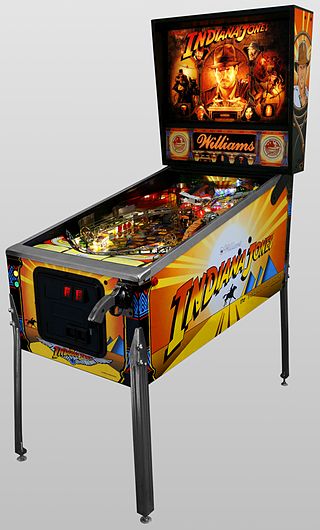
Indiana Jones: The Pinball Adventure is a 1993 widebody pinball game designed by Mark Ritchie and released by Williams. It was based on the Indiana Jones movies. It was also part of WMS' SuperPin series of widebody games.
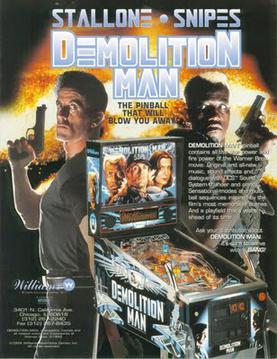
Demolition Man is a Williams pinball machine released in February 1994. It is based on the motion picture of the same name. It is part of WMS' SuperPin line of widebody games.

Fish Tales is a fishing-themed pinball game released by Williams in 1992. It is one of the top 20 most produced pinball machines of all time, selling more than 13,000 units.

The Flintstones is a pinball game released by Williams in 1994 and based on the movie of the same name which is based on 1960–1966 animated television series of the same name. This machine is not to be confused with another pinball machine, a redemption game, based on the TV series and also released in 1994, manufactured by Innovative Concepts in Entertainment (ICE).
Doctor Who is a pinball machine designed by Bill Pfutzenreuter (Pfutz) and Barry Oursler, and released by Midway in September 1992. It is based on the television series Doctor Who. As stated in the Gameplay section, the rulesheet is rather different from other pinball machines released at the time, which didn't help popularity as casual players did not understand the complex rule changes that occur during the game.

No Fear: Dangerous Sports is a 1995 pinball game designed by Steve Ritchie and released by Williams. It is based on the clothing line. This game has an extreme sports theme and features skydiving, free climbing, water skiing, extreme skiing, supercross and car racing. This was the last game Steve Ritchie designed for Williams.

Star Wars Episode I is a 1999 pinball game designed by John Popadiuk and released by Williams and the second machine to use the Pinball 2000 hardware platform. It is based in the Star Wars film The Phantom Menace.
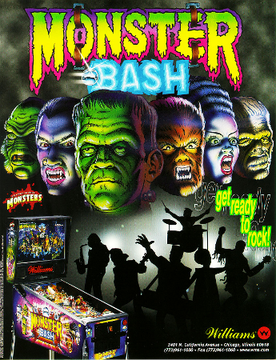
Monster Bash is a pinball machine produced by Williams. The game features some Universal Monsters including The Creature from the Black Lagoon, The Wolf Man, Frankenstein's monster, the Bride of Frankenstein, Dracula and The Mummy.
There have been four pinball adaptations of the film Jurassic Park franchise: a physical table released by Data East the same year the film came out, Sega's 1997 The Lost World which is based on the second movie of the series, a virtual table developed by Zen Studios on the franchise's 25th anniversary and a new physical table released by Stern Pinball a year after. All four tables behave differently.

Who Dunnit is a Midway pinball machine with a 1940s style and a murder mystery theme. The playfield features up to five different murder mysteries in which the player must find clues and evidence by making indicated shots. The machine accepts up to four players, and features four-ball play.

Space Shuttle is a Space Shuttle themed pinball machine designed by Barry Oursler and Joe Kaminkow and produced in 1984 by Williams Electronics. The machine's marketing slogan is "The fastest way to make your earnings really take off!". It is notable for its central ramp shot up a feature themed after the Space Shuttle. A sequel, Space Station: Pinball Rendezvous, was released in 1987.

Judge Dredd is a four-player pinball game produced by Bally Manufacturing in 1993, based on the British comic strip Judge Dredd in 2000 AD. Nearly 7,000 were made.

Hurricane is a pinball machine released by Williams Electronics in August 1991. It was designed by Barry Oursler as the third game in Oursler's amusement park themed pinball trilogy. The first being Comet, released in 1985, and the second being Cyclone, released in 1988.


















